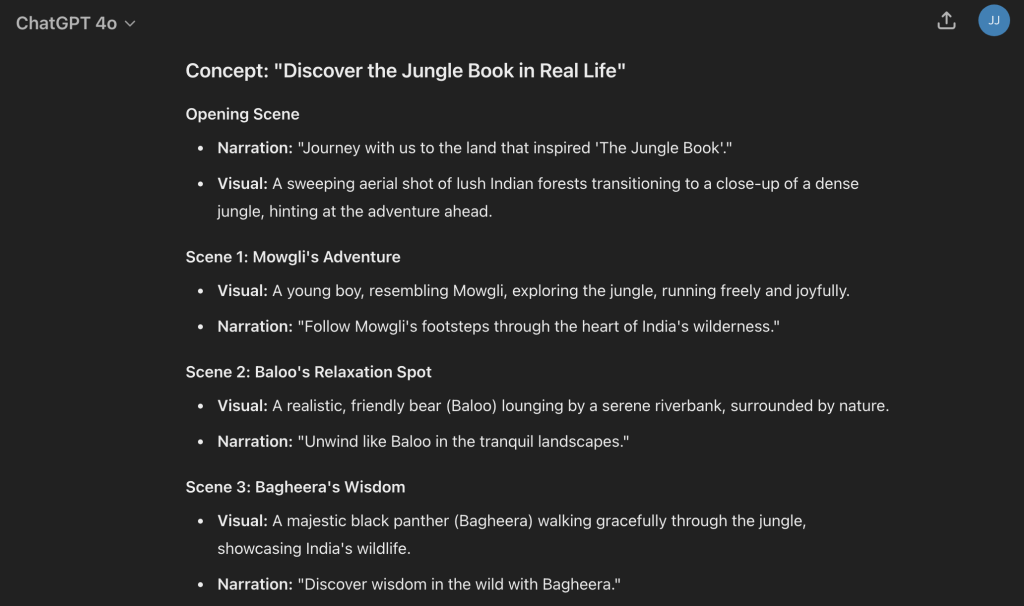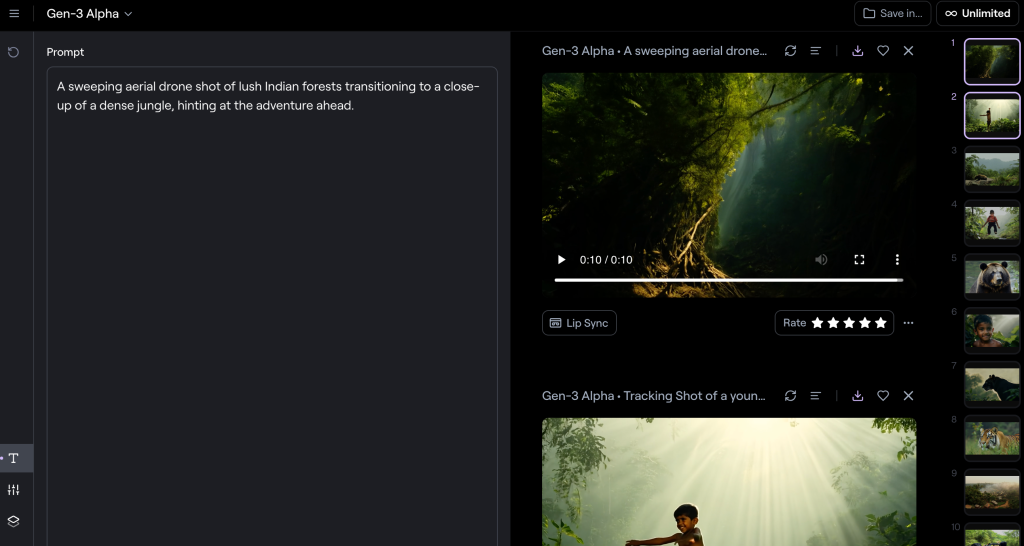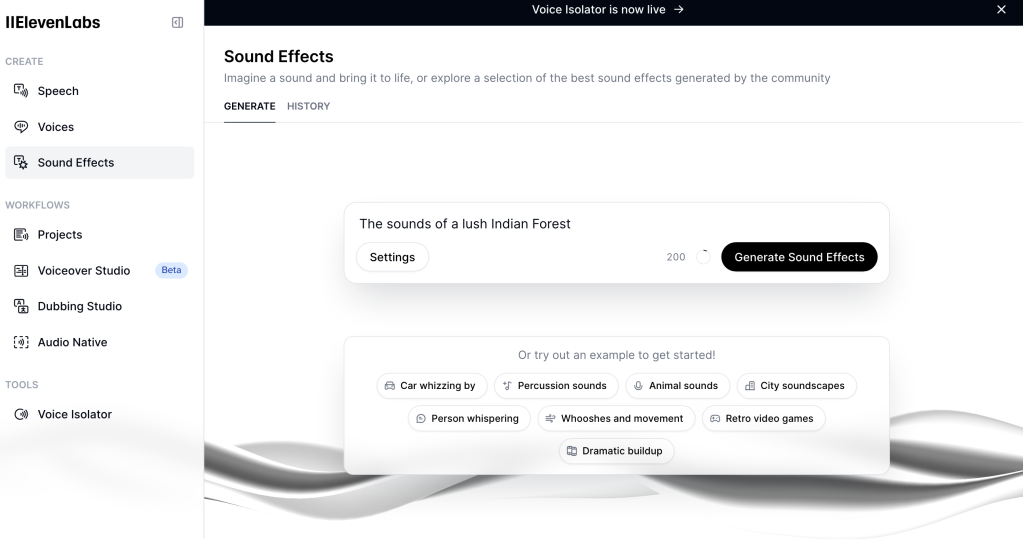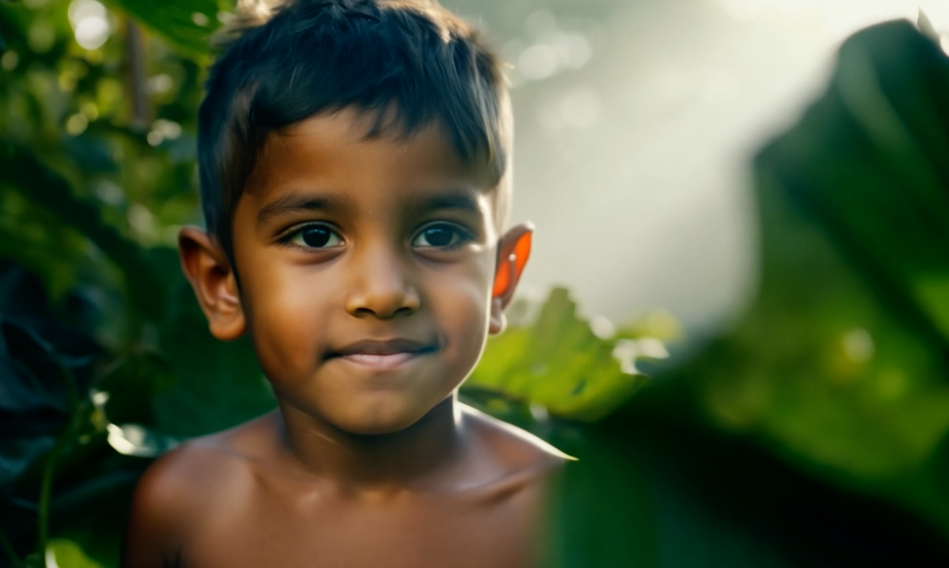I’ve been experimenting with RunwayML’s Gen-3 Alpha, aiming to create something more captivating than just random (but cool) video shots stitched together. After searching for funny and memorable travel ads recently (and to continue the theme of testing travel content like we did with AI generated text to images a while ago), I decided to lean into it and combine two of my passions: “The Jungle Book“** (a story I fondly remember watching as a kid with my mom in a theater) and India, a land rich in heritage and natural beauty (and the place where I was born). Here’s the final product:
**“The Jungle Book” by Rudyard Kipling, originally published in 1894, is in the public domain. This includes the original text and characters like Mowgli, Baloo, Bagheera, Shere Khan, and others as they appear in Kipling’s work.
And here’s how that creative journey unfolded…
The Vision
The idea was to create a roughly 60-second ad that’s creative and heartwarming. I wanted to showcase India’s breathtaking landscapes, rich culture, and stunning wildlife, using realistic depictions of characters like Mowgli, Baloo, and Bagheera. The goal was to make viewers feel like they were stepping into the pages of “The Jungle Book,” in India, all the while testing the AI text to video capabilities of RunwayML’s Gen-3 Alpha.
Tools of the Trade
To bring this vision to life, I used a combination of the following tools:
- RunwayML Gen-3 Alpha for creating realistic video shots.
- ElevenLabs for generating the narration and sound effects.
- Suno for crafting the background music.
The Process
1. Storyboarding and Concept Development:
The first step was to outline the story. Using the help of ChatGPT 4o, I landed on scenes like Mowgli exploring the jungle, Baloo relaxing by a river, and Bagheera moving gracefully through the wilderness. This helped in setting the tone and ensuring a cohesive narrative. You don’t need to use ChatGPT (or even use the paid version at $20 per month)…another robust LLM / chatbot should do the trick too, e.g. Claude Sonnet 3.5, Google Gemini, etc.

2. Generating Video Shots with RunwayML Gen-3 Alpha:
RunwayML was instrumental in creating lifelike video shots. It was amazing to see how it could render detailed, realistic scenes. However, it wasn’t without challenges. Fine-tuning the visuals to get the right shots and movements took several iterations in many cases, especially where they involve people or generation of text. You’ll find a detailed prompting guide here. Gen-3 Alpha isn’t available free, so you’ll likely need to splurge for the unlimited tier ($95 per month), so that you can generate enough shots and variations for your project without (very quickly) running out of credits.

3. Adding Audio and Sound Effects with ElevenLabs:
Next, I used ElevenLabs to generate the audio narration for the video, as well as natural jungle sounds – birds chirping, rivers flowing, and even animal calls. Integrating these sounds added depth to the visuals, making the scenes more immersive. At its most basic, a starter account with ElevenLabs costs about $5 per month.

4. Crafting Background Music with Suno:
The background music was a blend of traditional Indian instruments and modern beats, thanks to Suno (Udio does a great job too!). This combination helped in maintaining an emotional connection throughout the ad. I used the free version of the tool, which allows a few generations every day.

Technical Challenges and Limitations
1. Realism vs. Artistic Control:
One of the biggest challenges was achieving the right level of realism while retaining artistic control. AI tools are incredibly powerful, but they sometimes produce results that are too polished, lack the desired emotional touch or are just plain glitchy (e.g. unwanted artifacts, unnatural movements, wonky Physics, backward motion and hands are still a challenge). We’ve come a LONG way with photo generation and tools like Midjourney do an amazing job now…video still has some way to go, even with the amazing leaps taken by RunwayML’s Gen-3 Alpha, Pika Labs, Luma Labs’ Dream Machine, OpenAI’s Sora (still not publicly available) and others. It’s just a matter of time though – I suspect in another year we’ll be seeing some pretty flawless video generations.
2. Integration of Different Elements:
Seamlessly integrating video, audio, and music was another hurdle. Ensuring that the timing and synchronization were perfect required meticulous attention to detail. I used my go-to video editing tool, Final Cut Pro X for this, though Adobe Premiere, DaVinci Resolve or other tools would work equally well.
3. Computational Power and Quality:
Creating high-quality AI-generated media is resource-intensive. The processing power required can be substantial, making it a challenge for those without access to high-end computing resources. For example, RunwayML’s Gen-3 Alpha currently outputs at a maximum of 1280 × 720 pixels (HD resolution)…I didn’t upscale the footage to Full HD as I have an old computer and running the clips through a tool like Topaz Video AI would have probably taken 10-12 hours!
Pros and Cons of Using AI-Generated Media for Travel
Pros:
- Cost-Effective: Once set up, AI tools can significantly reduce production costs. In this example, the overall cost was well below $100, if you factor in the various subscription fees and less than a day’s worth of usage.
- Speed: AI can expedite the creative process, generating content faster than traditional methods. The overall process took me less than 3 hours.
- Customization: AI allows for easy customization and personalization, tailoring content to specific audiences.
Cons:
- Lack of Human Touch: Despite its capabilities, AI-generated media can often feel less authentic. This is especially important in a space like travel…how do you know if what’s being represented on video is actually real? Guess it raises the age old question…just because you can, should you use AI to create travel content?
- Technical Barriers: High computational requirements and technical knowledge (both prompting techniques and a lot of patience) are necessary to achieve optimal results.
- Ethical Considerations: The use of AI in media raises questions about creativity, authorship, and authenticity.
Wrap Up
Creating this AI-generated travel ad was a fun experience for me personally, mainly as I love tinkering with new tech…and the fact that Gen AI opens up a whole new world of access and creativity for me. While there were challenges, the end result was a pretty usable and interesting portrayal of India, seen through the lens of “The Jungle Book.” These tools are only going to get better from here…and that does raise interesting questions about creativity, authenticity, the nature of work and how we tap into this tech without losing human connection.
Excited to see where this journey takes us next. Stay tuned for more adventures in AI and travel!
Other Related Articles:
You’ll notice how far we’ve come in terms of AI text to video generation when you see the output from the last 12-18 months!


0 comments on “Creating The First AI Travel Ad For Less Than $100 – Visit India, The Real Life Jungle Book”